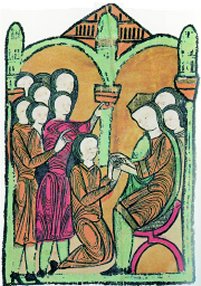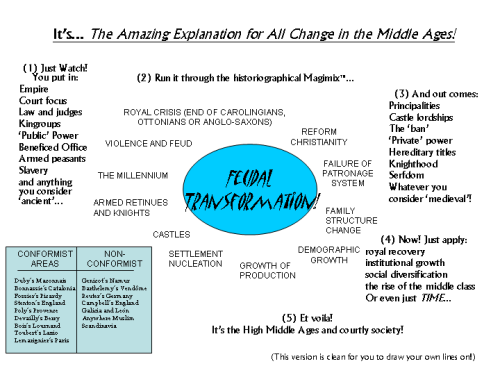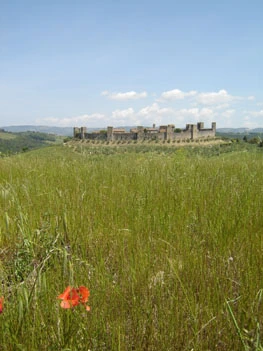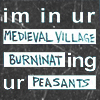
Chris Wickham setting up for the Eric Hobsbawm Memorial Lecture at Birkbeck, University of London, 14 May 2019, photograph by your author
Well, I am back and I made a promise, and so here is the post which was promised, in which as has happened here a few times before I sing Chris Wickham’s praises. This is not musing on the his classic works of the 1980s or even 1990s, however, because this post is reporting on the Eric Hobsbawm Memorial Lecture at Birkbeck, University of London, on 14th May 2019, which was given by Chris and which had the title, “How did Feudalism Work? The Economic Logic of Medieval Societies”. I was there—and it was a little odd to be back in my alma mater as a guest rather than as a student—and I took extensive and enthusiastic notes, but the lecture has since emerged as an article, under a slightly different title, in Past & Present for May 2021.1 So I’ve checked the article against my notes on the lecture, but I think having done so that a report on the lecture gets you the substance of the article without misrepresenting it; so, here goes.
To start with we have (of course) to define what we mean by ‘feudal’. Chris was addressing the term in the strictly Marxist sense, as an economic ‘mode’, in which the productive class, for the Middle Ages the peasantry, have more or less full direction of their own labour, but do not get to keep the proceeds, or at least are subjected to rent, levy, tribute, pre-emption or whatever else one might call it by the governing class, whose lifestyle and endeavours, including of course all government, are made possible by their right or ability to appropriate that peasant surplus. We’re not talking feudalism as in knight service, fiefs and vassals, arbitrary violence and private justice or anything like that, though those things might also have been present in some of the societies concerned, but just the economic relationship between producers and governors.2 Now, for most commentators this is a restrictive system, with no room for growth, because it rests fundamentally on the basis of peasant farming, and that can only be ratcheted up so far and only so much surplus extracted from it before peasants can’t survive; other than extract more from them, the only obvious means of growth for such an economy is to farm more land with more people, and there are usually effective limits on that too. For those same commentators, Marx was right that the game-changing phenomenon was industrialisation, which enabled the development of capitalism, in which the ruling class control the productive class’s labour directly, take all the proceeds and then pay the proletariat thus created for that labour. Marxist dialectic sees the end of the Ancien Régime and the Age of Revolutions as the messy and difficult transition of European society from the ‘feudal’ to the ‘capitalist’ mode, and from aristocratic land-owning ruling classes to bourgeois, commercial ones.
OK, so far, so much Marxism 101. But despite the Middle Ages usually being characterised as ‘feudal’ in this sense, it’s pretty easy to point to things like factory-scale industrial production of textiles in Flanders and Florence, plantation sugar cultivation in Sicily, day-labourers in England and many other places, extensive peasant access to markets and commercial goods, banking and credit and of course the rise of the middle class, a phenomenon which as someone I didn’t know once said at a paper I was at is one of those that seems to have happened in every age that anyone studies, and which then propelled the development of self-governing towns and so on. Quite a lot of this looks capitalistic, even if it really only seems to be visible after 1100, and it has led to angry if sterile debates about whether the profit motive was known in the Middle Ages, how rational an economic actor the medieval peasant was, and so on.3 And, whatever its mysterious cause, the medieval economy did manage a quite substantial amount of growth, punctuated by some dramatic but not total collapses. Probably no-one would disagree that the number of people and average standard of living, if what we mean by that is availability of market goods, was vastly higher in 1450 than in 550 despite the Black Death intervening (though, to be fair, 550 was also a plague period).4 So if this was a feudal economy, how did it contain all that?

To this, a question which Chris himself had raised, his answer was brilliant and simple. Firstly, probably no society ever has been entirely formed around a single Marxian mode of production; we’re only ever talking about the dominant one. England didn’t become instantly capitalist the minute the first factory started operation, and the Middle Ages could accommodate a few textile manufactories without needing reclassifying, because so much more of the overall economy than that, even than Florence, was economically constructed on the ‘feudal’ basis. But the second part of the argument was for me the winner: actually, historically speaking, feudal economies could be very complex, could expand, and could do so quite a lot. Indeed, since the Middle Ages show that they could, by Chris’s argument, the real question is not ‘whether’ but ‘how’, and to that Chris said firstly that evidently, normally, peasants could amass a surplus of their own and were thus consumers and an economic force on the market alongside the lords who had the first claim on their stuff; the proportionally less the lords took, the more peasant action on the market there could be and the more market-based the economy could get. But peasants were not themselves dependent on that access to the market, because they were in control of production; if they didn’t get to keep enough to feed themselves, the whole economy stopped, but if there was difficulty, obviously the first thing peasants would do was look after themselves and withdraw from the wider economy. These capitalist-looking super-phenomena would then shrink or disappear. Because of this basic safety valve in a feudal system, it would never reach conversion point and become capitalist without some other factor developing. Such an economy could be stable, large and complex, even slightly industrialised, and remain feudal.
This didn’t meet much opposition in questions; instead, there was a small slew of people asking ‘do you think such-and-such-a-place fits or doesn’t?’, to which Chris naturally enough said that they all fitted if you looked at it right; someone asking about wage labour, which Chris thought was never very important, since seasonal labourers must still also have fitted into the economy some other way the rest of the year; and Caroline Goodson, suggesting the importance of at least Islamic states as economic drivers, to which Chris argued that as long as it was taxing peasants without telling them how and what to farm, the state was just a big lord in economic terms and his classification was safe. I didn’t get to ask my question in the session, but did get to catch Chris a bit later, and what I wanted to know was, what doesn’t fit into a feudal classification like this? Wouldn’t the whole ancient world, except the very few bits and times of it which really did run on plantation slavery, be ‘feudal’ in these terms? And if so, what did this mean for Chris’s early work, still much cited, on the transition from the ancient to feudal modes in late antiquity?5 And Chris said, yes, it pretty much would, and what this meant was that he’d been wrong. This actually rocked my thought-world a bit, not just because of someone with Chris’s stature disavowing some of his most influential writing but also because I still find ‘The Other Transition’ and ‘Marx, Sherlock Holmes, and Late Roman Commerce’ intellectually compelling and explanatory. But so did I this. It has taken me some effort to prune the old work from my reading lists since then, and I’m still not sure it’s pruned from my own picture of fourth- to eighth-century European and Mediterranean change, despite the pretty major mounting block presented by Chris’s work in between.6 So for me at least, the way I used to understand about a thousand years of European history and indeed focus on about five hundred of them has changed because of this lecture, which is the power a really brilliant bit of work can have. But since the print version is very much the same paper, that is an experience you too can have, and I do recommend it!
1. Chris Wickham, “How did the Feudal Economy Work? the Economic Logic of Medieval Societies” in Past & Present No. 251 (Oxford 2021), pp. 3–40. It probably is worth mentioning that Chris reckons this article a partner to his earlier “Productive Forces and the Economic Logic of the Feudal Mode of Production” in Historical Materialism Vol. 16 (Leiden 2008), pp. 3–22, which I haven’t read, and should therefore mention so that you can.
2. My checkpoint for these distinctions remains Chris Wickham, “Le forme del feudalesimo” in Il Feudalesimo nell’alto Medioevo, Settimane di Studio del Centro Italiano di Studi sull’Alto Medioevo 47 (Spoleto 2000), 2 vols, I, pp. 15–51, but there is a quick run-through in Wickham, “How did the Feudal Economy Work?”, pp. 8-10.
3. For the latter, see Cliff T. Bekar and Clyde G. Reed, “Open fields, risk, and land divisibility” in Explorations in Economic History Vol. 40 (Amsterdam 2003), pp. 308–325, ridiculed at the post linked. We might also note the weird branch of this scholarship which sees the Church as the only capitalist force of the Middle Ages, and thus essentially assumes, as do all those who like to bash the corruption and cynicism of the medieval Church, that everyone who believed was actually outside the organisation which mediated belief; for the one see Robert B. Ekelund, Robert D. Tollison, Gary M. Anderson, Robert F. Hébert and Audrey B. Davidson, Sacred Trust: The Medieval Church as an Economic Firm (Oxford 1996) and for the latter Alan Ereira, Terry Jones’ Medieval Lives (London 2005).
4. On the plague of c. 550 see Peter Sarris, “The Justinianic Plague: origins and effects” in Continuity and Change Vol. 17 (Cambridge 2002), pp. 169–182, though just lately a rook of exciting new work on it and its consequences has emerged that I haven’t yet followed up, beginning with Merle Eisenberg and Lee Mordechai, “The Justinianic Plague: an interdisciplinary review” in Byzantine and Modern Greek Studies Vol. 43 (Abingdon 2019), pp. 156–180. We still lack a general economic history of the medieval period that I’d trust: Norman Pounds, An Economic History of Medieval Europe, 2nd edn, (London 1994) is OK in a traditional mould, but that’s kind of it. However, the last time I spoke to Chris Wickham, only a few weeks ago, he referred to an ‘economy book’ that he’d just sent to the press, and I wonder if that will prove to be the thing we need…
5. This work is collected and revised in Chris Wickham, Land and Power: studies in Italian and European social history, 400–1200 (London 1994), but includes especially idem, “The Other Transition: from the Ancient World to Feudalism” in Past & Present No. 103 (Oxford 1984), pp. 3–36, rev. in idem, Land and Power, pp. 7-42, and idem, “Marx, Sherlock Holmes, and Late Roman Commerce” in Journal of Roman Studies Vol. 78 (London 1988), pp. 183–193, rev. in idem, Land and Power, pp. 77-98. Of course John Haldon, a long-ago colleague of Chris, was arguing even then that ancient and medieval states worked in fundamentally the same way in Marxist terms, and wanted rid of both ‘ancient’ and ‘feudal’ modes in favour of a more capacious ‘tributary’ mode: see John Haldon, The State and the Tributary Mode of Production (London 1993).
6. Most obviously Chris Wickham, Framing the Early Middle Ages: Europe and the Mediterranean 400-800 (Oxford 2005), to which cf. Historical Materialism Vol. 19 no. 1, Symposium on Chris Wickham’s Framing the Early Middle Ages (Leiden 2011).


















